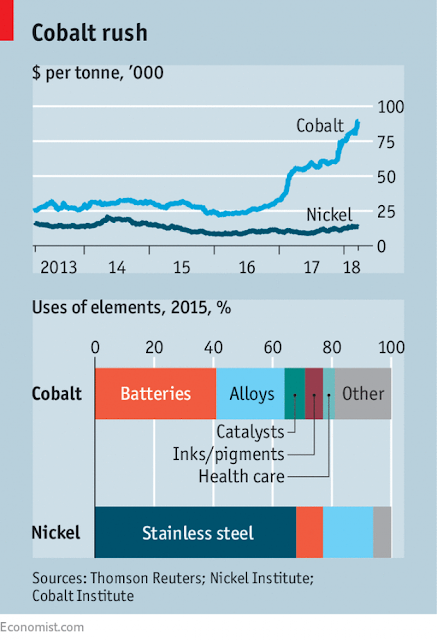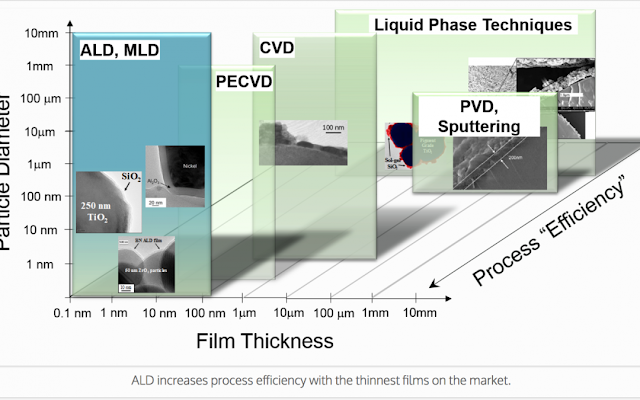There
is an ongoing boom in the materials supply chain industry to supply the
Electrical Vehicle manufacturers with battery materials. There are a
number of concerns in the supply of the actual materials (e.g. Lithium,
Cobalt and graphite). The technological aspects are also still broad,
however it seems very likely that ALD will play a role for some of the
technologies for producing future lithium batteries that we will use in
basically all devices ranging from communication (smart phones) and for
transportation (cars, trucks, trains, ships, airplanes).
Alumina ALD Coating on LiCoO2
cathode particles showing a clear improvment in battery cyclability.
The ALD coated material (red) shows improved capacity retention compared
to uncoated (black). (ALD Nano)
ALD
Nano in Boulder Colorado is the pioneer in this technology area and has
recently announced scaling up their technology to run high volume of
powder (3000 kg/day). They have developed a Spatial vibrationg
technology refered to as Continious Vibrating Reactor - CVR.
The scientific, process development and engineering teams at ALD Nano
have spent considerable resources over the past few years rapidly
developing this first-of-its-kind technology from research scale,
bench-top to the current commercial-scale systems. A continuous
vibrating reactor, or CVR, provides ALD coating capacity of more than
three tons per day and 1,200 tons per year of particle materials. These
techniques gained from equipment development open up new pathways for
ALD Nano's growth. The CVR is a spatial ALD reactor system and can also
be utilized for MLD techniques, run at atmospheric or pressurized
conditions, and fitted with various features such as plasma. [LINK]
It
seems to me that their technology is mature for high volume
manufacturing of powder materials and that they "simply" by scaling the
number and/or the size of plants can supply the know how and hardware
for full scale production for any big player in the battery materials
supply chain.
ALD
Nano was recently highlighted by the Colorado Cleantech Industries
Association (CCIA) and here is the information given by their CEO, Wayne
Simmons:
Battery Breakthrough Company Feature: ALD NanoSolutions
CCIA [
LINK] : We asked several companies “What are the critical changes in the battery
industry landscape that will have a strategic impact on your success?”
This week, we’re highlighting
ALD NanoSolutions.
Wayne Simmons, CEO
Lithium
ion batteries for electric vehicles, consumer electronics, and
distributed energy storage, along with new versions of lead acid
batteries for vehicle start-stop fuel efficiency strategies, are driving
today’s growth in the battery energy storage market. Longer term,
grid-scale batteries will generate a large impact too. Overall, the
dramatic changes and expansion of the battery industry are creating huge
new materials markets. Every major chemical and advanced materials
company in the world is attracted to this opportunity. However, for new
devices like EVs to take meaningful market share, the materials for
electrodes, electrolytes, and other battery components need to be
engineered at the nanometer, or even atomic, scale. It is this demand
for engineering new materials that improve energy storage, safety, and
power management metrics, combined with the desired cost stack of inputs
to the final battery price, that has a big impact on ALD Nano’s
business. The key for us to succeed is to enable the new battery
materials with atomic layer deposition technologies that not only solve
various technical challenges to reach performance metrics, but can also
scale at very low cost.
About ALD NanoSolutions ALD NanoSolutions (ALD Nano) is creating cost-effective advanced
materials through its unique portfolio of atomic layer deposition
technologies to transform industries.



.jpg/1200px-Robert_Bosch_GmbH_Zentrum_f%C3%BCr_Forschung_und_Vorausentwicklung_-_panoramio_(11).jpg)




























_2_(18624618923).jpg)
_.jpg/1200px-Nickeline_(Cobalt%2C_Ontario%2C_Canada)_.jpg)

